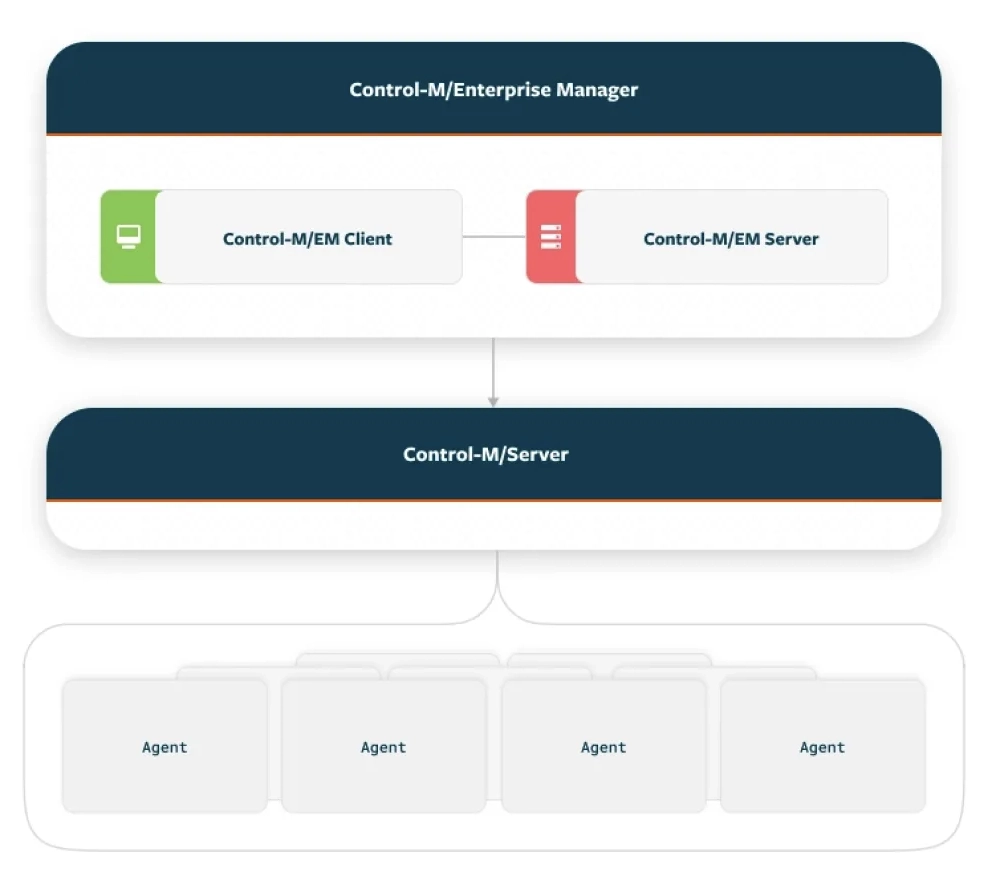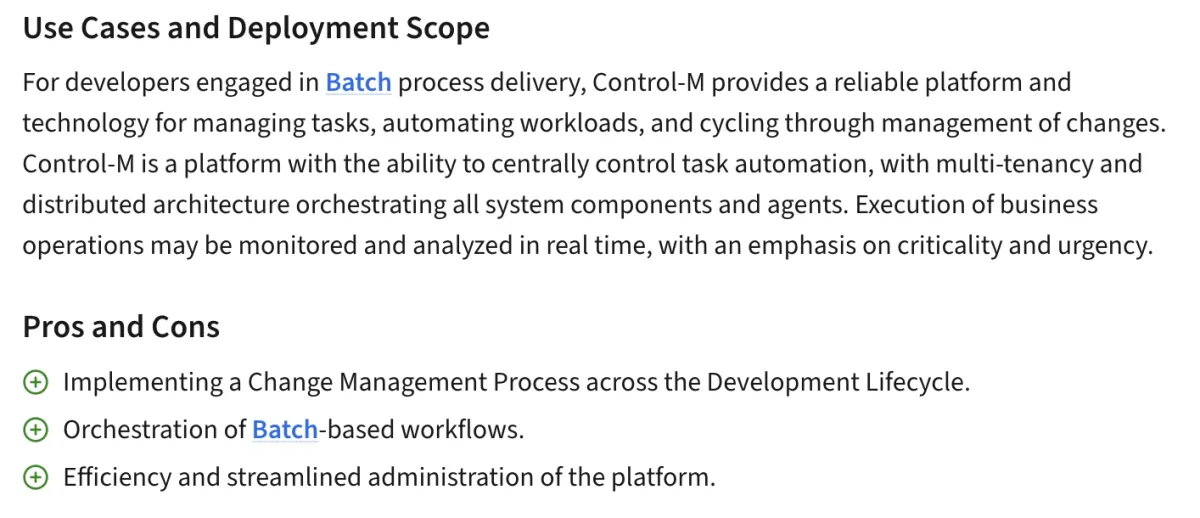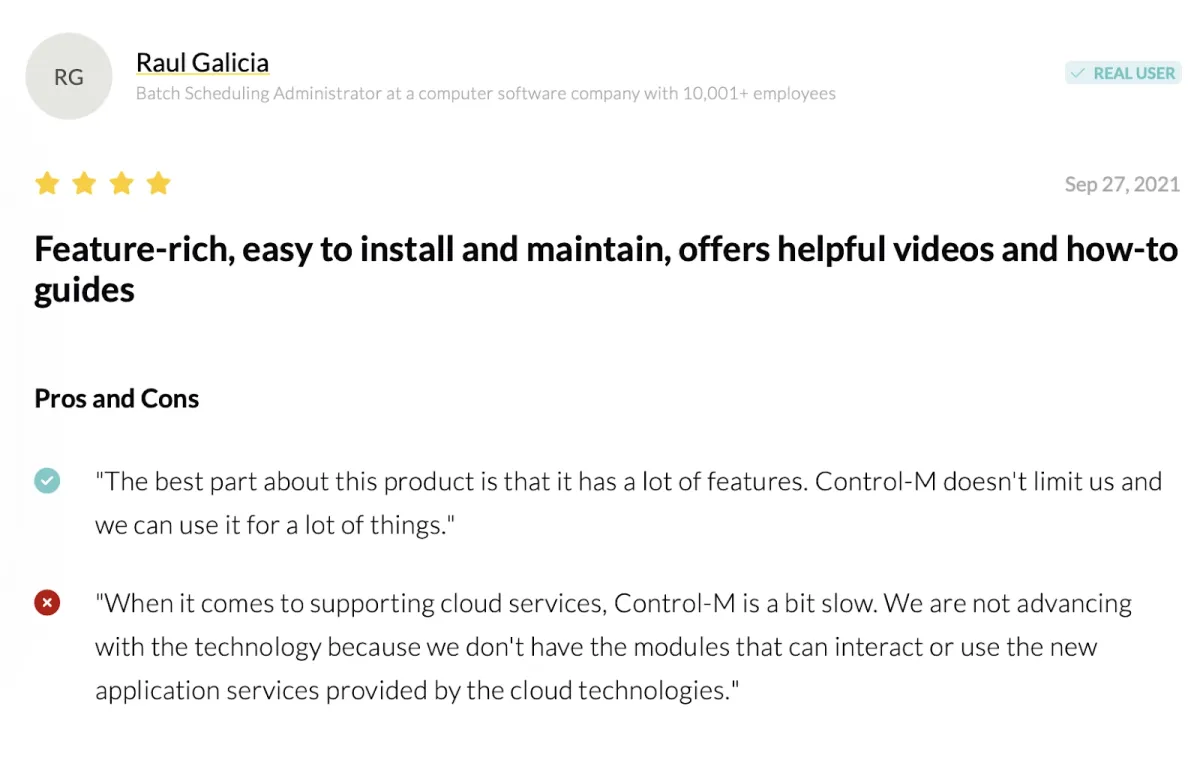IT automation trends indicate increased uptake in workload automation; 82% of participants have adopted workload automation, and 47% view automation as one of the top two drivers of digital transformation.
Among the workload automation software designed to streamline enterprise job scheduling, Control-M scheduler has carved a niche. This article aims to provide an exhaustive understanding of Control-M Scheduler, elaborating on its architecture, features, benefits, and shortcomings within the enterprise ecosystem.
Features and Capabilities
Cross-platform support
Control-M provides a unified scheduling environment that can integrate across various operating systems, such as Windows, UNIX, Linux, and mainframe systems like z/OS. This cross-platform support ensures that organizations do not need to switch between different scheduling tools for different platforms.
Application integration
Control-M offers out-of-the-box integrations with enterprise applications, including ERP systems like SAP, data warehouses, and big data platforms like Hadoop. This reduces the need for custom scripting and helps unify the workflow across different software stacks.
Centralized monitoring and control
Its Enterprise Manager (Control-M/EM) provides a centralized dashboard for monitoring all jobs and tasks. This interface allows administrators to perform corrective actions, rerun jobs, and forecast completion times.
MFT capabilities
Control-M MFT Enterprise is an MFT add-on that enables users to securely transfer and receive files to and from external users outside their organization.
Advanced scheduling capabilities
Control-M supports various scheduling options, including time-based, event-based, and condition-based scheduling. This allows enterprises to create complex workflows with multiple dependencies, optimizing resource utilization and operational efficiency.
Scalability and flexibility
Control-M is capable of handling a large number of jobs per day. Its architecture is designed to scale horizontally, enabling enterprises to expand their automation scope as they grow.
Improved compliance and auditing
Control-M features built-in compliance and auditing capabilities. It offers detailed reporting features, helping organizations easily adhere to regulatory standards and governance models.
Workflow orchestration across cloud
The software allows for an end-to-end orchestration of workflows within hybrid cloud environments. This includes immediate provisioning on machine and support for cloud services like AWS Lambda, Step Functions, and Batch, Azure Data Factory, Azure Logic Apps, Functions, and Batch AWS Glue, Azure Databricks, AWS Databricks, Azure Functions, Boomi, GCP Cloud Functions, GCP Dataproc, Power BI, and UI Path.
Jobs-as-code
Jobs-as-Code approach enables integration with REST APIs and JSON to increase application build, test, and validation times. With Jobs-as-Code, Control-M helps reduce costs and improve quality by identifying defects earlier in the software development lifecycle.
Different WLA platforms have different capabilities, and you may want to explore alternatives if you encounter issues in your Control-M experience; check out Control-M alternatives and top Windows Job Scheduling software.
Architectural Overview
Control-M Scheduler is an enterprise-grade scheduling solution developed by BMC Software. It is a part of the broader Control-M Workload Automation suite and is designed to automate the scheduling and monitoring of jobs and tasks across various applications and platforms.
The architecture of Control-M is modular, consisting of several components such as the Control-M Server, Control-M/Agent, and Control-M/EM (Enterprise Manager).
- Control-M Server: The core of the Control-M architecture, responsible for the scheduling and management of tasks.
- Control-M/Agent: A software component installed on each server that executes the jobs as instructed by the Control-M Server.
- Control-M/EM: The GUI interface for administrators, offering real-time monitoring and managerial control over the tasks.
Figure 1 shows the logical architecture of the Control-M environment.

Figure 1: Control-M Architecture.1
These components ensure end-to-end automation of complex workflows in a multi-platform, multi-application environment.
Evaluation of Control-M based on user reviews
Customer reviews obtained from B2B review platforms can inform about the performance of Control-M:
| Platform | User ratings | Number of reviews |
|---|---|---|
| PeerSpot | 4.4/5 | 109 |
| Trustradius | 7.2/10 | 104 |
| G2 | 4.4/5 | 55 |
| Capterra | 4.4/5 | 3 |
Advantages of Control-M
Functionality and versatility
Users find Control-M’s workload automation and control task automation easy to use and efficient (See Figure 2).

Figure 2: Control-M user review on Trustradius.2
File transfer component and integrations
With Control-M, users can easily integrate with databases and products such as Informatica and SAP. Users also find Control-M’s file transfer component useful and valuable (See Figure 3).

Figure 3: Control-M user review on PeerSpot.3
Precautionary Alerts
Users state that Control-M enables them to save time when monitoring with the help of its alert system. (See Figure 4).

Figure 4: Control-M user review on PeerSpot.4
Shortcomings of Control-M
Performance Issues at Scale
While Control-M is designed for scalability, some users have reported performance bottlenecks when operating on a large scale with complex job dependencies.5 These limitations may require additional investments in hardware resources or software optimizations, thereby inflating operational costs.
Limited Built-In Cloud Support
While Control-M does offer cloud integration capabilities, they often require additional configurations or add-on modules. This can be a limitation for enterprises heavily invested in cloud services and looking for out-of-the-box cloud support for scheduling workloads. Some users reported constraints regarding cloud support (See Figure 5).

Figure 5: Control-M user review on PeerSpot.6
Lack of Community Support
As a proprietary software, Control-M lacks a broad community of independent developers contributing to its development or offering community support.
While BMC provides comprehensive support services, they come at a premium cost, and the absence of community-driven solutions could be a drawback for some organizations. Users have reported constraints regarding the community and networking.7
Recent developments in Control-M
Introduction of Control-M for Airflow
Control-M for Airflow has recently introduced end-to-end visibility of the Airflow Directed Acyclic Graph (DAG) and a single orchestration that operates with Control-M data and application workflows.
This integration facilitates advanced orchestration functionalities, granting data teams access to all Control-M features while integrating with Airflow.
Additionally, it allows various stakeholders, such as IT operations, developers, and business users, self-service access to Airflow pipelines.8
Managed File Transfer Enhancements
Control-M made significant enhancements to The MFT and MFT Enterprise versions, such as native support for multi-cloud storage platforms and advanced encryption for data in transit and at rest. These enhancements aim to facilitate simpler file transfers, boost data protection, and empower internal teams and external partners with easier file transfer management.9
If you have further questions, reach us:
External Links
- 1. “Control-M“. BMC. Retrieved February 21, 2024.
- 2. It's easy to Manage workflow and tasks with Control-M. | TrustRadius. TrustRadius
- 3. Control-M reviews 2025.
- 4. Control-M reviews 2025.
- 5. Control-M reviews 2025.
- 6. Control-M reviews 2025.
- 7. Control-M reviews 2025.
- 8. What’s New in Control-M - BMC Software.
- 9. What’s New in Control-M - BMC Software.


Comments
Your email address will not be published. All fields are required.